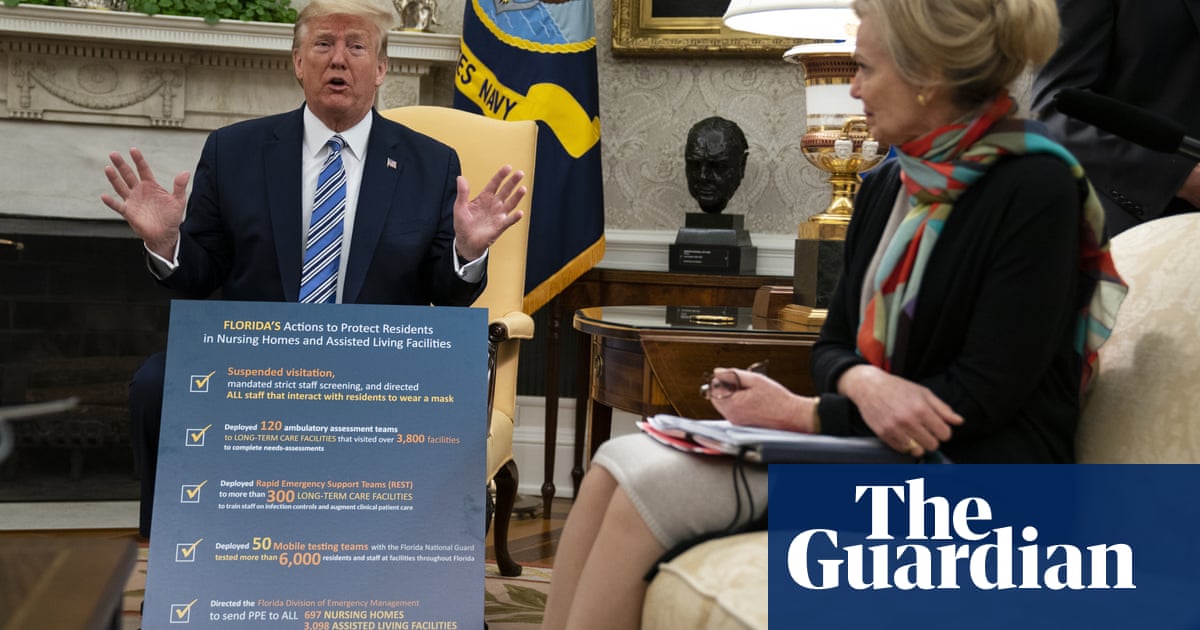
The White House has released guidance pushing responsibility for Covid-19 testing on to state governments in a political strategy that has been criticised as “terrible” for public health.
However, under pressure to ramp up testing as several states make moves to reopen, Donald Trump’s announcement instead continues to send mixed messaging around testing targets, with most of the burden falling on states.
“They know that the federal response has been a disaster, and so now their strategy is blame 50 states,” Ashish K Jha, faculty director of the Harvard Global Health Institute, told the Guardian.
Jha has spoken to White House officials who acknowledge the need for far more testing, which they understand will be difficult to do “unless the federal government takes direct responsibility”, he says.
“If I know that the only way to fix this is federal, and yet I’m saying I’m gonna make the states responsible, it’s another way of saying I know this isn’t gonna work,” Jha said.
Following early setbacks, the US has scrambled to scale up diagnostic testing as part of a strategy to safely reopen the country. But current testing levels are still far from where they need to be, experts warn, even as restless Americans crowd beaches and parks and states such as Texas and Georgia begin to relax their stay-at-home orders.
Dr Anthony Fauci, an infectious disease expert and key member of the White House’s coronavirus taskforce, said on Saturday that the country was performing between 1.5m and 2m diagnostic tests a week.
“We probably should get up to twice that as we get into the next several weeks, and I think we will,” he said, though he added that “testing is an important part but it’s not the only part”.
Trump and some of his allies are congratulating themselves for efforts they’ve already made on testing and predict exponential growth in capacity. “We’re going with maximum testing, because it’s something we’re very capable of doing,” Trump said Monday. “We’ll be much more than doubled.”
But another administration official has said the federal government actually means for states to test at least 2% of their residents monthly, according to the New York Times, a rate not dissimilar from the one now.
CVS Health and Walgreens, two of the US’s major pharmacy chains, announced they were expanding free testing, with CVS aiming for as many as 1.5m tests each month, USA Today reported.
More than 190,000 new tests were reported nationwide on Monday, according to the Covid Tracking Project, a gargantuan boost compared with the single digits recorded only two months before. But as the country steamrolls into May, 500,000 diagnostic tests will represent “the bare minimum” per day to capture most infected people and assuage Americans’ concerns, said Jha, a threshold that still hasn’t been reached on any single day so far.
“Identifying who’s infected, who’s not is like public health, disease control 101. Without that, you’ve got nothing,” Jha said. “If you can’t test people for the virus, you cannot figure out who’s infected, you can’t keep them away from susceptible people, you can’t run your economy.”
Not all states will necessarily be equally affected, as an outbreak’s size drives testing needs, Jha said. In an analysis he and his team collaborated on with Stat, projections show that New York will require upwards of 100,000 more tests per day starting in May to catch most infected people in time. This despite the state’s already impressive infrastructure, where more people have been tested than anywhere else in the US.
Texas, on the other hand, has been disparaged for its lack of testing. But Jha’s analysis shows the state is actually performing enough tests for early May, if social distancing measures remain in place. The Texas governor, Greg Abbott, has instead announced that he will allow some businesses to reopen on Friday, a move with unclear consequences.
“This is the key about the virus, is any action you take today, you won’t see the benefits or the costs for several weeks,” Jha said.
Meanwhile, antibody tests – once touted as a potential measurement for who could safely re-enter society after developing immunity to the disease – have taken on a lesser role as the country actually moves toward reopening. Such a minuscule proportion of the US population has been exposed to the virus, and false positives on immunity tests abound, Jha said. But perhaps even more significantly, there is “no evidence” that recovered Covid-19 patients cannot get infected again, even if they have antibodies, the World Health Organization wrote on Friday.
“Most of us believe that having antibodies should be protective for most people, but that’s a lot of caveats,” said Jha. “I don’t feel like we should make policy based on luck.”
Source: US Politics - theguardian.com



